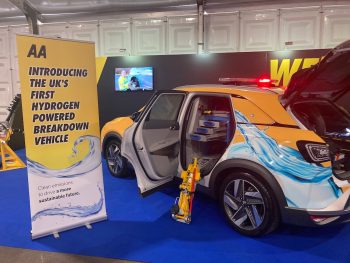AA launches hydrogen patrol vehicle in UK-first
The AA has put a toe in the water of hydrogen fuel cell electric vehicles with the unveiling of its new FCEV patrol car.

The hydrogen fuel cell Hyundai Nexo SUV has been configured as an operational roadside breakdown vehicle
Revealed at the British Motor Show this week, it uses a hydrogen fuel cell Hyundai Nexo SUV configured to operate as roadside breakdown vehicle.
It’s fitted out with the most of the tools, equipment and spares that you would find on the rest of the AA’s yellow patrol fleet and will target breakdown jobs in ultra-low emission areas that require fixes rather than tows.
The SUV-style vehicle has a fuel cell system and combines oxygen and hydrogen to create a flow of electrons that powers the electric drive motor and charges the 1.56kWh high-voltage battery.
Benefits of the technology include the ability to refuel in just five minutes and a range of 414 miles (WLTP), which is more than enough for city work and potentially can handle many of the 10,000 daily breakdowns that the AA attends.
The breakdown specialist said the Nexo showed how the organisation is evolving to assist its members while aligning with its recent net zero commitment.
Edmund King, AA president, commented: “The discussions about carbon reduction and zero emission vehicles have tended to concentrate on battery electric vehicles (BEVs).
“At the AA we are investing in electric vehicles but believe that there will be a role for hydrogen and possible synthetic fuels in the future, especially for business fleets.
“We want patrols to pilot this hydrogen fuel cell vehicle to see what lessons we can learn. We believe hydrogen might be used for our bigger tow trucks in the future.”
He also noted that the current hydrogen refuelling infrastructure is not extensive, and further work is needed on the development of green hydrogen, but added that the 414-mile range makes the vehicle viable for its needs.
King continued: “As part of our ESG strategy we believe that driving doesn’t have to cost the earth and we’re committed to reducing our impact and supporting drivers to do the same. To achieve this the AA has recently announced its commitment to become net zero for our own emissions by 2035, including our greenhouse gas emissions generated by our operational fleet which are the AA’s most significant source of direct emissions.
“This is an ambitious target, as there isn’t yet a van in production that can run on alternative fuel and meet all our needs. We have tested many vehicles and will continue to trial new technology as it becomes available while investing in innovation that reduces our environmental impact. We’re also partnering with others to help develop the tech that’ll make it easier to transition to electric and lower carbon emission vehicles.
“As part of this target we are rolling out electric vehicles into our operational fleets, where we can and trialling other low carbon vehicles and technology across our group, like hydrogen chargers and vehicles to gain learning and understanding how these vehicles could be used in the future.”
The AA already has several EV vans on its fleet that are used for activities that don’t involve towing, and has revealed several of them at the British Motor Show this week.
It’s also introduced EVs into its driving school fleet, and King said these are proving very popular with both instructors and pupils.












